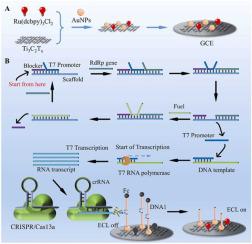Journal of Hazardous Materials ( IF 13.6 ) Pub Date : 2023-03-22 , DOI: 10.1016/j.jhazmat.2023.131268 Jihua Wei 1 , Zichun Song 2 , Jiuying Cui 2 , Yuanxun Gong 1 , Qianli Tang 1 , Kai Zhang 3 , Xinlei Song 4 , Xianjiu Liao 2

|
In this study, we introduce an electrochemiluminescence (ECL) sensing platform based on the "Entropy-driven triggered T7 amplification-CRISPR/Cas13a system" (EDT-Cas). This platform combines a programmable entropy-driven cycling strategy, T7 RNA polymerase, and the CRISPR/Cas13a system to amplify the determination of the SARS-CoV-2 RdRp gene. The Ti3C2Tx-compliant ECL signaling molecule offers unique benefits when used with the ECL sensing platform to increase the assay sensitivity and the electrode surface modifiability. To obtain the T7 promoter, the SARS-CoV-2 RdRp gene may first initiate an entropy-driven cyclic amplification response. Then, after recognizing the T7 promoter sequence on the newly created dsDNA, T7 RNA polymerase starts transcription, resulting in the production of many single-stranded RNAs (ssRNAs), which in turn trigger the action of CRISPR/Cas13a. Finally, Cas13a/crRNA identifies the transcribed ssRNA. When it cleaves the ssRNA, many DNA reporter probes carrying -U-U- are cleaved on the electrode surface, increasing the ECL signal and allowing for the rapid and highly sensitive detection of SARS-CoV-2. With a detection limit of 7.39 aM, our method enables us to locate the SARS-CoV-2 RdRp gene in clinical samples. The detection method also demonstrates excellent repeatability and stability. The SARS-CoV-2 RdRp gene was discovered using the "Entropy-driven triggered T7 amplification-CRISPR/Cas13a system" (EDT-Cas). The developed ECL test had excellent recoveries in pharyngeal swabs and environmental samples. It is anticipated to offer an early clinical diagnosis of SARS-CoV-2 and further control the spread of the pandemic.
中文翻译:

熵驱动辅助 T7 RNA 聚合酶扩增激活 CRISPR/Cas13a 活性,用于通过电化学发光生物传感器检测人咽拭子和环境中的 SARS-CoV-2
在本研究中,我们介绍了一种基于“熵驱动触发的 T7 扩增-CRISPR/Cas13a 系统”(EDT-Cas) 的电化学发光 (ECL) 传感平台。该平台结合了可编程的熵驱动循环策略、T7 RNA 聚合酶和 CRISPR/Cas13a 系统,以放大 SARS-CoV-2 RdRp 基因的测定。Ti 3 C 2 T x当与 ECL 传感平台一起使用时,兼容 ECL 信号分子可提供独特的优势,以提高检测灵敏度和电极表面可修改性。为了获得 T7 启动子,SARS-CoV-2 RdRp 基因可能首先启动熵驱动的循环扩增反应。然后,在识别新创建的 dsDNA 上的 T7 启动子序列后,T7 RNA 聚合酶开始转录,导致产生许多单链 RNA (ssRNA),进而触发 CRISPR/Cas13a 的作用。最后,Cas13a/crRNA 识别转录的 ssRNA。当它切割 ssRNA 时,许多携带 -UU- 的 DNA 报告探针在电极表面被切割,增加了 ECL 信号并允许快速和高度灵敏地检测 SARS-CoV-2。检测限为 7.39 aM,我们的方法使我们能够在临床样本中定位 SARS-CoV-2 RdRp 基因。该检测方法还表现出出色的重复性和稳定性。SARS-CoV-2 RdRp 基因是使用“熵驱动触发的 T7 扩增-CRISPR/Cas13a 系统”(EDT-Cas) 发现的。开发的 ECL 测试在咽拭子和环境样本中具有出色的回收率。预计它将提供 SARS-CoV-2 的早期临床诊断,并进一步控制大流行的传播。


























 京公网安备 11010802027423号
京公网安备 11010802027423号